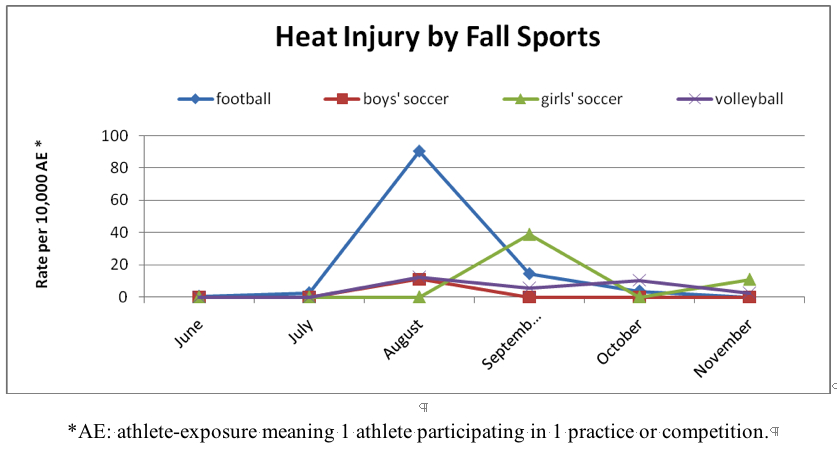Jan 29, 2015H.S. Heat Illness By The Numbers
 By Dawn Comstock, PhD
By Dawn Comstock, PhD
Researchers from The Center for Injury Research and Policy at The Research Institute at Nationwide Children’s Hospital in Columbus, Ohio share their analysis of heat illness and hydration for high school athletes.
With fall sports in full swing, athletes across the country are working hard to take the field in hopes of a winning season. Coaches, athletic trainers, and athletes are all diligently preparing themselves for the rigors of competition. As sports medicine professionals, our job is help keep athletes healthy and on the playing field.
Preventing athletes from preseason injury is key to their success. There are several basic steps that can be taken by all coaches and athletic trainers to decrease the risk of heat-related illness during their preseason conditioning programs.
How common are dehydration and heat illness in high school athletes? The National High School Sports-Related Injury Surveillance Study is currently the only instrument in the US collecting nationally representative data of such incidences among high school athletes. During the past four academic years, this study collected 119 cases of heat illness or dehydration. These 119 cases represent a nationally estimated incidence of almost 38,000 cases, suggesting that roughly 9,500 US high school athletes sustain some type of heat illness or dehydration-related event every year. The majority of these events (75 percent) occur during practice, with over half (63 percent) of these occurring during preseason.
Although most (80 percent) heat illness and dehydration events occurred among football players, it is important to note that athletes of other sports are not immune. Almost six in 10 athletes were able to return within a few days of the incident, likely due in part to timely on-the-field diagnosis and treatment. However, a small fraction (3 percent) missed at least three weeks of play or did not return to their sport. As you can see in the accompanying graph, athletes are most susceptible to heat injury during the month of August. This is likely due to the combination of the seasonal heat, two-a-days, conditioning drills, and inactivity of athletes over the summer.

Every case of dehydration and heat illness is preventable. Here are a few simple things you can do to prevent these conditions:
- Appropriate hydration before, during, and after exercise is important.
- Acclimate your athletes to hot weather by gradually increasing the training intensity.
- If multiple practices are held during the day, ensure that break periods in-between are adequate.
- Mandate water breaks at least every 10-15 minutes during activity. All athletes should drink during these times, regardless of whether or not they are thirsty.
- Avoid sports drinks that contain caffeine or ephedrine. Also, avoid very cold drinks, which can cause stomach cramps.
- Refer to a heat index chart to determine if practices should be modified.
- Use weight charts to monitor all athletes before and after warm weather practices. Athletes with over 3 percent weight loss should not be allowed to return to practice until they have replaced their weight.
- Encourage athletes to wear lightweight, light-colored clothing. Do not permit athletes to wear any rubber clothing, which prevents the skin from properly regulating body temperature.
- In sports with large amounts of protective equipment, such as football and boys’ lacrosse, gradually increase the amount of protective gear over several days.
- Pay particular attention to athletes with higher body fat percentages, as they can become dehydrated faster than athletes with lower body fat percentages.
- Be on the lookout for potential signs of heat illness–nausea, vomiting, incoherence, lightheadedness, excessive fatigue, visual disturbance, and chills. Any case of dehydration or heat illness has the potential to become severe, and should be treated seriously. Remove the athlete from activity immediately, lower his or her body temperature, give fluids, and consult a physician.
Dawn Comstock, PhD, is a principle investigator at the Center for Injury Research and Policy at The Research Institute at Nationwide Children’s Hospital. She is also an assistant professor at The Ohio State University in the College of Medicine and the College of Public Health. Her research interests include the epidemiology of sports, recreation, and leisure activity-related injuries among children and adolescents as well as the life-long health benefits associated with an active childhood. She can be reached at [email protected].



